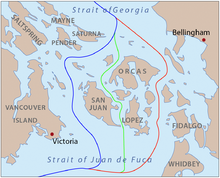Pig conflict
| date | 1859 |
|---|---|
| place | Border between Washington and British Columbia |
| output | The San Juan Islands were assigned to the United States of America . |
| Parties to the conflict | |
|---|---|
| Troop strength | |
| 461 men | 2,140 men |
| losses | |
|
0 fallen |
0 fallen |
The Pig War ( Engl. Pig War , Pig Episode , San Juan Boundary Dispute , Pig and Potato War or Northwestern Boundary Dispute ) was a territorial dispute in 1859 between the United States and Great Britain regarding a boundary curve between the Washington Territory and British North America . The name comes from the fact that the only victim was a pig .
The border between the United States and British North America was established by the Treaty of June 15, 1846, the so-called Oregon Treaty (along the 49th parallel, in the middle of the canal that separates the continent from Vancouver Island , and in the middle the Strait of Juan de Fuca to the Pacific Ocean ).
However, there are two waterways that run through the middle of the channel: Haro Strait west of the San Juan Islands and Rosario Strait along the east side. Because of the ambiguity, both the US and UK claimed the San Juan Islands for themselves. 13 years later, on June 15, 1859, this inaccuracy in the contract led to an open conflict: The American farmer Lyman Cutlar shot a strange pig that was running around in his garden.
course
The pig belonged to Charles J. Griffin, an Irishman who worked on a nearby farm owned by the then British Hudson's Bay Company . Cutlar had previously complained unsuccessfully to Griffin about free-roaming pigs, who had pointed out that the entire local area belonged to the Hudson's Bay Company, to which Cutlar replied that it was US territory. When another pig appeared on his property on June 15, the farmer shot it, reported it to Griffin and asked him to keep his pigs away from the potatoes, to which the latter replied: “It is up to you to get your potatoes out of my pig Hold on! ”Cutlar offered to pay him $ 10 in compensation, but Griffin refused because his pig was worth more than $ 100. When Cutlar refused to pay this high amount, British authorities threatened him with imprisonment and with the US settlers on the island being evicted as intruders.
When the resident US settlers found out about this, they called for the military. Oregon Department Head William S. Harney immediately dispatched 66 soldiers from 9th Infantry Regiment under the command of Captain George Pickett to the island, knowing that orders from Washington would take weeks. When the British authorities found out, three warships were sent to the area under the command of Captain Geoffrey Hornby . The situation threatened to escalate. In September 461 Americans with 14 field cannons and eight 32 pounders naval guns under the command of Major Silas Casey were ready to face the three British warships with 70 guns and 2,140 soldiers. However, there was no fighting at any time.
US President James Buchanan sent General Winfield Scott to San Juan Island in September to work with Governor James Douglas to solve the crisis. The result was that both sides agreed to retain the common occupation, albeit to a reduced extent. The British camp was set up on the north side of the island to ensure easy supplies and easy access; the American camp was set up on a high point on the south side of the island, convenient for artillery.
The crisis had already been going on for twelve years when the dispute was brought up to the German Kaiser Wilhelm I , who was supposed to mediate. On October 21, 1872, a commission formed by the emperor decided that the San Juan Islands would fall to the United States. To this day, a memorial commemorates this conflict, the San Juan Island National Historical Park . The place has been a National Historic Landmark since 1961 .
See also
Web links
- Berthold Seewald: When the USA almost went to war for a pig . In: Welt, October 20, 2019
- Greater Victoria Public Library - The Pig War (English)
- The Pig War (English)
- The Pig War of San Juan Island ( Memento from January 20, 2008 in the Internet Archive )
Individual evidence
- ^ "It is up to you to keep your potatoes out of my pig" Chuck Woodbury: How one pig could have changed American history. Out West Newspaper, Edmonds WA, archived from the original on August 6, 2013 ; accessed on July 12, 2018 .
Coordinates: 48 ° 27 '41.9 " N , 123 ° 0' 23.8" W.

